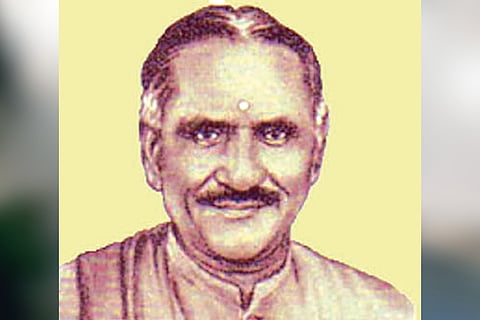

Chennai
“Kathiyindri rathamindri yutham ondru varuguthu”
(Without a sword, without bloodshed, comes a war...)
Perhaps this was the aptest piece of poetry describing the ahimsa-driven Indian freedom movement. It was written for the salt satyagrahis (of Vedaranyam) who sang it to forget the tire of their marching legs and pain of police lathis.
The poet was Namakkal Ramalingam, who ironically started as a portrait painter and a British loyalist. His father was a head constable serving the Raj. In an era of confused loyalties, Ramalingam drew a picture for the 1911 coronation durbar. It was Mother India crowning the British emperor for which he got a gold medal.
Ramalingam developed an interest in sketching early in life. He started doodling people around him parodying their facial features. In higher school, he was trapped caricaturing his headmaster, who, wild at the size of his extended nose, caned Ramalingam.
Consistent ear pain made him come to Madras for treatment. Dr Nair (later of the Justice Party) treated him. He was relieved of pain but Ramalingam suffered hearing loss in one ear.
Meanwhile, there were clear indications of the direction he was moving in. After graduating he was employed in the tahsildar’s office. To his bad luck, the tahsildar walked in behind him when Ramalingam unable to resist temptation was caricaturing a tufted head clerk. This led to a tussle and he resigned from his job.
Refusing to take a job as his father ordered, Ramalingam honed his portrait painting skills to the level they were often mistaken for prints (he had to sign, drawn by hand, VR Lingam). His first breakthrough was when a British PWD chief engineer Simpson gave him a photo of his dead baby and asked for a portrait of it as if living. Promised Rs 50 (three times the monthly salary of a government servant) a tearful engineer paid him all the money he had in his pocket, Rs 675, on seeing it.
As a participant in the art competition for Delhi Durbar, he would get an entry pass to the celebration. Ramalingam, impressed with British rule would describe Delhi durbar as Devendra’s capital. He got a gold medal for his painting and was introduced to the King-Emperor in a reception in Shahjahan’s peacock throne hall. Then he travelled all across the north-west frontier up to the Khyber Pass.
Getting a medal in the durbar built his brand and Ramalingam would become an acclaimed portrait painter in wealthy Chettinad.
Meanwhile, the poetic muse within him was stirring too. As a policeman’s son Ramalingam had free access to drama theatres. Most plays were all night musicals and there was a great demand for poets to write songs for them. Ramalingam could instantly conjure up a song for a situation. He became a full-fledged poet, writing for drama giants like SG Kittappa.
Ramalingam wanted to meet Subramanya Bharathi and he travelled to Pondicherry where the poet was in exile. Nine times he would go to the poet’s house only to learn he wasn’t at home. Once when he was doing a portrait in Karaikudi he heard Bharathi was staying in a nearby village. Commandeering a bullock cart Ramalingam and his friend would travel the bumpy path. He would sing a song for Bharathi who was very impressed (much later Rajaji would write that Ramalingam compensated his worry that Bharathi wasn’t alive any more).
Soon, in a wholesome transition, Ramalingam would abandon all other commercial pursuits and follow up on nationalistic songs of which he penned hundreds. The man who drew the Bharatha Matha crowning the British emperor had changed completely.
In 1914, a whole year before Gandhi returned to India from South Africa, Ramalingam wrote a song on him for a nationalistic competition and it was rejected for nobody at that point thought Gandhi was of any relevance in Indian politics.
Much later, Ramalingam had organised Gandhi’s visit to Karur and when Rajaji cancelled it, Ramalingam and others would barge into the Mahatma’s room and convinced him.
Ramalingam became a much in demand on-stage singer and speaker. There were many police warrants issued for him. However, the song that made him famous was “rathamindri…” It was printed in lakhs and became a household song and an icon for the Gandhian style freedom struggle.
Post Independence, Ramalingam was not forgotten and was designated the first poet laureate of independent Madras, a title reminiscent of the ancient Tamil kings who had a resident poet in the court.
As a novelist, Ramalingam is mainly known for Malai Kallan (a Robinhood-type thriller) which was filmed in several languages including Sinhalese and established the career of MGR as a swashbuckling hero.
Namakkal Kavignar Maligai, though a concrete monstrosity amid a British fortress, was named after him and is an 11-storied building at the Fort St. George campus.
— The writer is a historian and an author
Visit news.dtnext.in to explore our interactive epaper!
Download the DT Next app for more exciting features!
Click here for iOS
Click here for Android